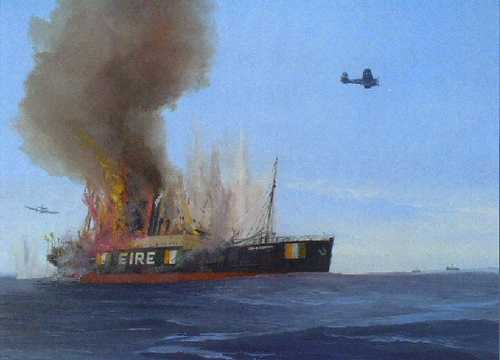
Posters Artwork Documents
Sinking of the S.S. "City of Limerick".
Maritime Institute of Ireland (National Maritime Museum of Ireland)/Kenneth King.
While she supplied Great Britain with substantial numbers of workers and substantial quantities of food throughout the war, Ireland continued to depend for vital imports substantially on its small merchant fleet. In spite of being recognised as neutral by both sides, this fleet suffered a loss of some 16 ships in the course of the war as a result of various mistakes on the part of combattant units and mine strikes. This was a very significant volume of attrition in view of the small Irish tonnage. This is an artist's view of the sinking of the Irish merchantman, "City of Limerick", owned by Palgrave Murphy Ltd. On 15 July 1940, this ship was in transit from Cartagena, Spain, to Liverpool with a cargo of fruit for inspection. About 100 miles off Ushant, it was attacked by a German aircraft (type unidentified). Two men were killed when the ship was strafed with machinegun fire. Bombing resulted in serious damage and disablement of the ship, forcing the captain to abandon it. Subsequent bombing sent the "City of Limerick" to the bottom. The survivors were picked up by a Belgian trawler and landed in Cornwall. Note the large Irish tricolour and the word "EIRE" painted on the side of the ship to identify it as Irish (the deck would have been similarly marked). This was standard practice for Irish ships during the war - but sometimes it did not save them from attack. By the way, in view of a recent query on copyright, I should say that this image is from a painting by Kenneth King, commissioned by the Maritime Institute of Ireland and on view in the National Maritime Museum of Ireland. It has been licensed in general for reporduction, subject to acknowledgement of artist and source, by the rightsholders. Oh - and may I wish a Happy St Patrick's Day to all In Here ! Best regards, JR.
2336 Views
3/17/2011
